
March 29, 2023 By Michael Weymouth
As most everyone who follows the culture wars knows, CRT (Critical Race Theory) is a hot button issue these days. But even though many culture warriors claim to oppose it, few can explain why or what CRT actually is.
Conservative media has wasted no time in exploiting this lack of understanding and in the process has made the term CRT so toxic that their audience automatically demonizes it. Conservative politicians have piled on as well, falsely claiming that young children are not ready for racially sensitive discussions, when in fact, CRT is not even taught in elementary schools. Some contend that CRT is a form of indoctrination aimed at dividing the country. Senate Minority leader Mitch McConnell adds, “Our nation’s youth do not need activist indoctrination that fixates solely on past flaws and splits our nation into divided camps.” Conservative politicians have also introduced bills banning the teaching of CRT in public institutions in Arkansas, Iowa, South Dakota, Mississippi, Texas and Missouri.
But what is Critical Race Theory ?
Critical Race Theory has been around for over 40 years. It is a cross-disciplinary examination – by social and civil-rights scholars and activists – of how laws, social and political movements, and media shape, and are shaped by, social conceptions of race and ethnicity. Its most recent iteration was inspired by The 1619 Project, a book written by New York Times journalist Nikole Hannah-Jones. Essentially Hanna-Jones contends that the teaching of American history should reflect the role slavery played in our nation’s development, from well before the writing of the Declaration of Independence to present day. (1619 was the year the first Africans set foot on US soil as slaves.)
Having read The 1619 Project, I found it a fascinating story. My greatest takeaway from the book was the pride today’s black Americans should take in the suffering of their forebears and the perseverance and strength it took to prevail against the oppressive institution of slavery, Jim Crow laws and today’s version of racism: white supremacy. Unfortunately black Americans had no Moses to part the waters to allow them to escape slavery. Lincoln came close in the Civil War, but 100 years of oppressive Jim Crow laws lay ahead.
Not surprisingly, my conservative friends refuse to read the book, claiming that it has been debunked by “many” historians, referring no doubt to a letter five historians wrote to the New York Times, which hardly qualifies as “many” historians: “None of us have any disagreement with the need for Americans, as they consider their history, to understand that the past is populated by sinners as well as saints, by horrors as well as honors, and that is particularly true of the scarred legacy of slavery. However, The 1619 Project offers a historically-limited view of slavery and asserts that every aspect of American life has only one lens for viewing, that of slavery, and its fallout.”
That would be true except for the fact that The 1619 Project is not a history book per se, in that it is not trying to meld “all” the aspects of our country’s history together; rather it makes the point that so much of that history leaves out the black experience.
These five historians aside, many history teachers have embraced The 1619 Project as an important part of their curriculum. Christopher Span, a history of education professor at the University of Illinois believes “The 1619 Project should be added to every undergraduate and graduate course surveying American history.” Span says, “Educating Americans to appreciate and understand this history affords opportunities for healing and reconciliation.” He is not alone in this belief as many other educators are including The 1619 Project in their programs.
Jonathan Zimmerman, an educational historian at the University of Pennsylvania, and a proponent of including CRT in his curriculum, contends that, “history courses in schools and college classrooms are intended to teach students ‘how’ to think, not ‘what’ to think.”
Randi Weingarten, the head of the American Federation of Teachers claims that teaching history, “requires all the facts available to us, including those that are uncomfortable.” Besides she adds, “teachers know they teach history, not hate.”
Hannah-Jones ends The 1619 Project with this reminder. “Citizens inherit not just the glory of their nation, but its wrongs, too. A truly great country does not ignore or excuse its sins. It confronts them, and then works to make them right.”


Teaching facts of history, no matter how uncomfortable, is the best way to address the wrongs of the past that have a lasting impact in our own time.
History is history, good and bad. Our children and youth should know the full story.